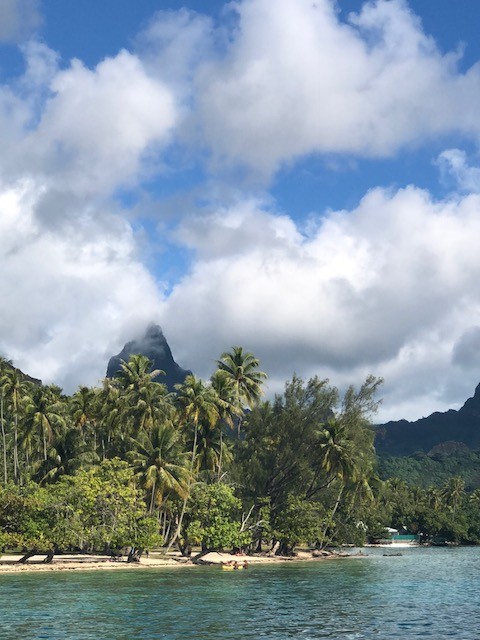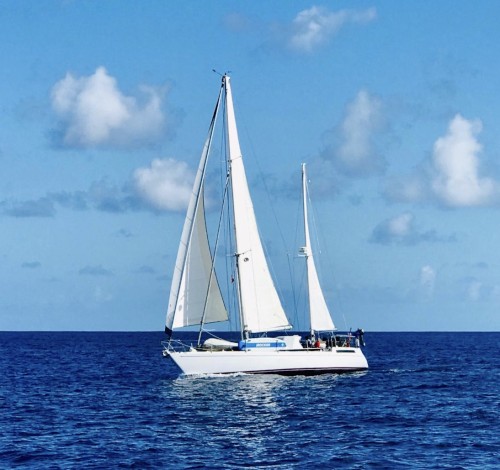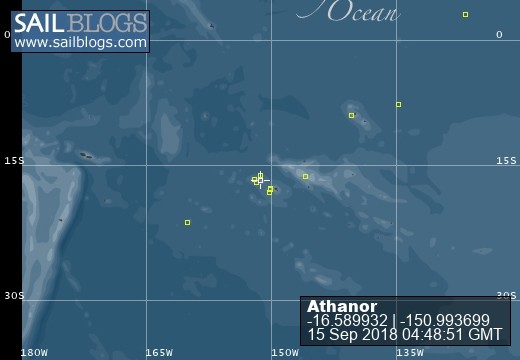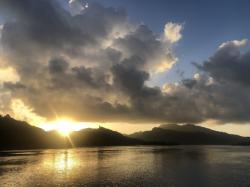Passage from Raiatea to Moorea: "One To Learn From"

It's 7am and the sound of roosters crowing wafts in with the fresh tropical breeze coming through the hatches over our heads. The boat is encrusted with salt. Susan and I are both exhausted and hungry. Sunday was a late night (our heads hit the pillow at 3:30am) and, waking up today, Monday morning, in Opunohu Bay on Moorea feels as if we've landed in another world. Ancient mountain peaks rising majestically toward the sky, palm trees lining the shore. With this grandeur, there's also a sense of familiarity, a sense of place where we have some great memories from time spent two years ago. Katia and Wolfe on Plastik Plankton. Nico on Yellow Feather, with his parents Pierre and Samantha. Peter, Karen, Sean, and Sarah on Batu, and 10 fun-filled days with daughter Kate!
Our last overnight passage was almost 21 months ago, the reverse of this trip actually, sailing from Moorea to Raiatea That sail was one the best, most idyllic sails we've had thus far. In contrast, last night's sail (16 hours in total) was absolutely one of the most miserable we've had thus far. Since being back this season, our longest sail was between Raiatea and Bora Bora. That sail is a 25 mile crossing, perhaps not unlike the transit from Long Beach or Newport to Catalina Island in Southern California. Or from Boston out to Nantucket (ok, similar, but clearly different). Returning from Bora a couple of weeks ago was everything one typically expects while sailing here in French Polynesia -- some passing squalls, fast rising winds shifting around the land, and then some amazingly smooth reaching and downwind sailing at 7-8 knots. All ending in the shelter of a lagoon with protective fringing reefs.
We thought we had done everything right. We took our time preparing the boat, stowing and tying everything down, thinking through our sail plan. Engine oil,cooling, and charging checked. Susan had planned for, and prepared, easy meals for us to eat while underway. We studied the weather, checking forecasts twice daily for the past five days. We compared notes with our friends on S/V Jacaranda who were planning the same trip as us - back to the windward island of Moorea.
Here's what went wrong...
Weather - we studied the forecast for several days prior; the various forecast models had good convergence, and all signs pointed toward: robust winds (16-17 knots); slight seas (1.3 meters, 9 seconds); a good sailing angle (100% reaching); and minimal rain. What we got: 20+ knot winds winds with sustained gusts of 26-28 knots; steep seas of 3 meters from the same direction as the wind, and with heavy confused wind chop added on top (ugh - recall perhaps your worst roller coaster ride ever); wind at 35-45 degrees on the nose (an upwind sail); seemingly endless squall conditions (eight hours of which was in the dark of a moonless night).
Sea sickness -- I was last seasick 3 years ago rounding Cape Flattery outside Neah Bay off the coast of Washington heading for San Francisco. Some 7500 miles later, this is the fist time since and I had not anticipated nor prepared for being sea sick. When the captain of the vessel gets sea sick, that's a big deal. More than me feeling bad, it's a safety issue for the entire boat and crew (Susan!). Any deck work that I might have done in the rolly seas to try and set ourselves up for better sailing either didn't happen or Susan took it on - brave companion that she is. On the foredeck, clipped in, putting a 2nd reef in the mains'l with 25 knots of wind and green water flowing across the deck. She's awesome! Susan also had to handle our radio communications, and really anything below decks as I really couldn't spend more than 30 seconds down there.
So what went wrong?
Sea conditions. I'm not entirely sure what signal we missed on this, but the hard lesson we've clearly not yet learned well enough is that sea state is as critical as, if not more critical than, wind conditions. Athanor can handle the winds without any problem, in fact she likes big winds in the right conditions - but the high winds combined with heavy and highly agitated sea states don't go well together for us or for any boat for that matter. Upon checking in this morning on our French Polynesia Magellan Net (an HF radio community of sailors like us), we learned there had been big winds and seas in Papeete yesterday and that today there is a hazardous marine warning for swells of 4+ meters. Good information, but too late.
Short weather window. We bet on a short weather window; favorable conditions were forecast for only one day, not leaving much room for unanticipated shifts on either side. Weather forecasting is more art than science, to be taken with a grain of ... salt.
Sea sickness. Susan put on a Scopalamine patch, and I should have done the same as well - I don't experience any of the side effects that some others do, so I should have done so if only as a smart precautionary step. Period.
Inadequate preparation for our first overnight passage in two years. I wouldn't say we were cavalier about the crossing, but we definitely missed a few things. Down below, we weren't prepared for rough weather. Drawers flew out, whole bookshelves emptied their contents in one singular motion. On deck, there were a few things that should have been sorted out better before departure -- Reefing lines, staysail sheets, path for jack lines, ways in which I secured Jerry jugs with fuel on deck. There were also a few nagging "projects" and repairs which, if made earlier, would likely have helped. Nothing critical, but annoyances that certainly don't help under stressful situations.
Plan B not well thought out - We could have turned north after a while to the leeward island of Huahine and found shelter in the lagoon on the east side of the island. But we had not completely thought through or researched that option in advance, nor had we thought through what our decision making criteria would be. I like to pride myself for always having plans B and C at the ready, but not this time.
What did we do right?
Upon Susan's good suggestion/insistence, we decided to motor sail a good portion of the trip through the night. With our sail area reduced for the high gusts, we were underpowered given the heavy seas. Sailing with the engine running allowed us to maintain a more consistent boat speed (and importantly, control) as we pushed through and rolled with the large swells. As sailors, we hate to run the motor. But if used wisely, it's a huge asset to ensuring safety - running the engine in reverse is also a way to slow the boat down in in heavy seas (Dashew).
We picked a familiar pass on Moorea that we knew we could enter safely at night. We had been here before, anticipated that we'd be in the lee of the island (blocking both wind and swells) and could transit the pass relatively easily. We also knew just where we wanted to anchor (with waypoints from our last visit). Easy, and safe for two weary voyagers.
We trusted in the boat. Athanor is fundamentally an extremely stout and sound vessel, well equipped and well maintained. In the end, as the wise Stuart Lochner once told us when we sailed down the Washington and Oregon coasts -- the boat can always handle a lot more than the people on board!
Captain Rob
Learning Never Ends (Josef Albers)
["One to learn from" credited to Andrew Payne (S/Y Eye Candy) via text at 3:30 am]
Our last overnight passage was almost 21 months ago, the reverse of this trip actually, sailing from Moorea to Raiatea That sail was one the best, most idyllic sails we've had thus far. In contrast, last night's sail (16 hours in total) was absolutely one of the most miserable we've had thus far. Since being back this season, our longest sail was between Raiatea and Bora Bora. That sail is a 25 mile crossing, perhaps not unlike the transit from Long Beach or Newport to Catalina Island in Southern California. Or from Boston out to Nantucket (ok, similar, but clearly different). Returning from Bora a couple of weeks ago was everything one typically expects while sailing here in French Polynesia -- some passing squalls, fast rising winds shifting around the land, and then some amazingly smooth reaching and downwind sailing at 7-8 knots. All ending in the shelter of a lagoon with protective fringing reefs.
We thought we had done everything right. We took our time preparing the boat, stowing and tying everything down, thinking through our sail plan. Engine oil,cooling, and charging checked. Susan had planned for, and prepared, easy meals for us to eat while underway. We studied the weather, checking forecasts twice daily for the past five days. We compared notes with our friends on S/V Jacaranda who were planning the same trip as us - back to the windward island of Moorea.
Here's what went wrong...
Weather - we studied the forecast for several days prior; the various forecast models had good convergence, and all signs pointed toward: robust winds (16-17 knots); slight seas (1.3 meters, 9 seconds); a good sailing angle (100% reaching); and minimal rain. What we got: 20+ knot winds winds with sustained gusts of 26-28 knots; steep seas of 3 meters from the same direction as the wind, and with heavy confused wind chop added on top (ugh - recall perhaps your worst roller coaster ride ever); wind at 35-45 degrees on the nose (an upwind sail); seemingly endless squall conditions (eight hours of which was in the dark of a moonless night).
Sea sickness -- I was last seasick 3 years ago rounding Cape Flattery outside Neah Bay off the coast of Washington heading for San Francisco. Some 7500 miles later, this is the fist time since and I had not anticipated nor prepared for being sea sick. When the captain of the vessel gets sea sick, that's a big deal. More than me feeling bad, it's a safety issue for the entire boat and crew (Susan!). Any deck work that I might have done in the rolly seas to try and set ourselves up for better sailing either didn't happen or Susan took it on - brave companion that she is. On the foredeck, clipped in, putting a 2nd reef in the mains'l with 25 knots of wind and green water flowing across the deck. She's awesome! Susan also had to handle our radio communications, and really anything below decks as I really couldn't spend more than 30 seconds down there.
So what went wrong?
Sea conditions. I'm not entirely sure what signal we missed on this, but the hard lesson we've clearly not yet learned well enough is that sea state is as critical as, if not more critical than, wind conditions. Athanor can handle the winds without any problem, in fact she likes big winds in the right conditions - but the high winds combined with heavy and highly agitated sea states don't go well together for us or for any boat for that matter. Upon checking in this morning on our French Polynesia Magellan Net (an HF radio community of sailors like us), we learned there had been big winds and seas in Papeete yesterday and that today there is a hazardous marine warning for swells of 4+ meters. Good information, but too late.
Short weather window. We bet on a short weather window; favorable conditions were forecast for only one day, not leaving much room for unanticipated shifts on either side. Weather forecasting is more art than science, to be taken with a grain of ... salt.
Sea sickness. Susan put on a Scopalamine patch, and I should have done the same as well - I don't experience any of the side effects that some others do, so I should have done so if only as a smart precautionary step. Period.
Inadequate preparation for our first overnight passage in two years. I wouldn't say we were cavalier about the crossing, but we definitely missed a few things. Down below, we weren't prepared for rough weather. Drawers flew out, whole bookshelves emptied their contents in one singular motion. On deck, there were a few things that should have been sorted out better before departure -- Reefing lines, staysail sheets, path for jack lines, ways in which I secured Jerry jugs with fuel on deck. There were also a few nagging "projects" and repairs which, if made earlier, would likely have helped. Nothing critical, but annoyances that certainly don't help under stressful situations.
Plan B not well thought out - We could have turned north after a while to the leeward island of Huahine and found shelter in the lagoon on the east side of the island. But we had not completely thought through or researched that option in advance, nor had we thought through what our decision making criteria would be. I like to pride myself for always having plans B and C at the ready, but not this time.
What did we do right?
Upon Susan's good suggestion/insistence, we decided to motor sail a good portion of the trip through the night. With our sail area reduced for the high gusts, we were underpowered given the heavy seas. Sailing with the engine running allowed us to maintain a more consistent boat speed (and importantly, control) as we pushed through and rolled with the large swells. As sailors, we hate to run the motor. But if used wisely, it's a huge asset to ensuring safety - running the engine in reverse is also a way to slow the boat down in in heavy seas (Dashew).
We picked a familiar pass on Moorea that we knew we could enter safely at night. We had been here before, anticipated that we'd be in the lee of the island (blocking both wind and swells) and could transit the pass relatively easily. We also knew just where we wanted to anchor (with waypoints from our last visit). Easy, and safe for two weary voyagers.
We trusted in the boat. Athanor is fundamentally an extremely stout and sound vessel, well equipped and well maintained. In the end, as the wise Stuart Lochner once told us when we sailed down the Washington and Oregon coasts -- the boat can always handle a lot more than the people on board!
Captain Rob
Learning Never Ends (Josef Albers)
["One to learn from" credited to Andrew Payne (S/Y Eye Candy) via text at 3:30 am]









Comments